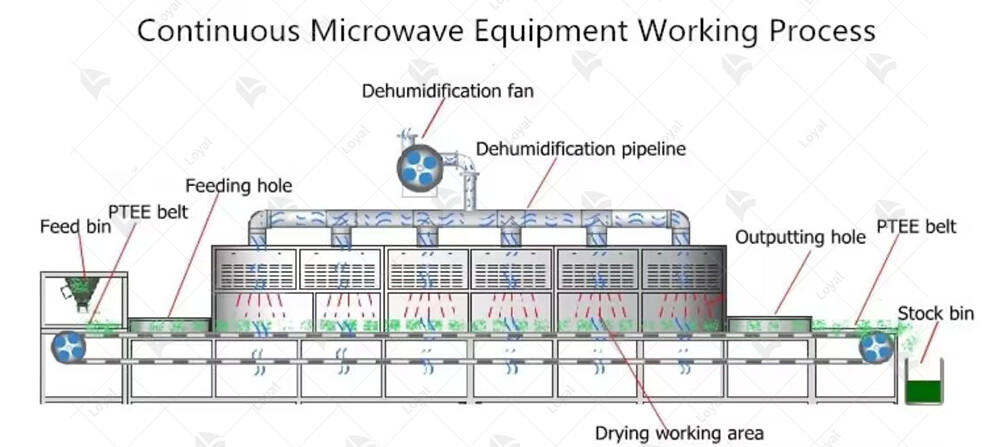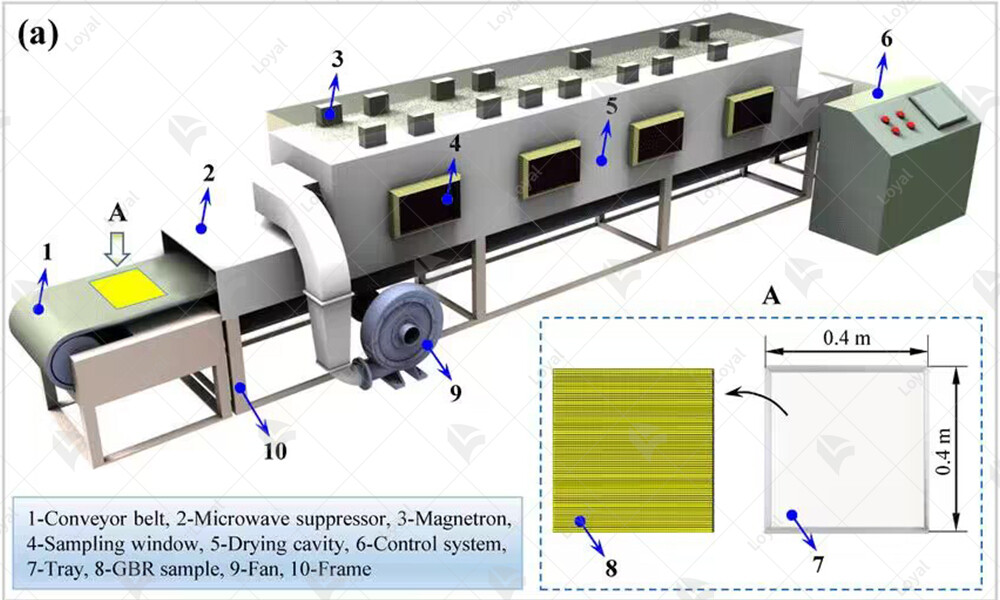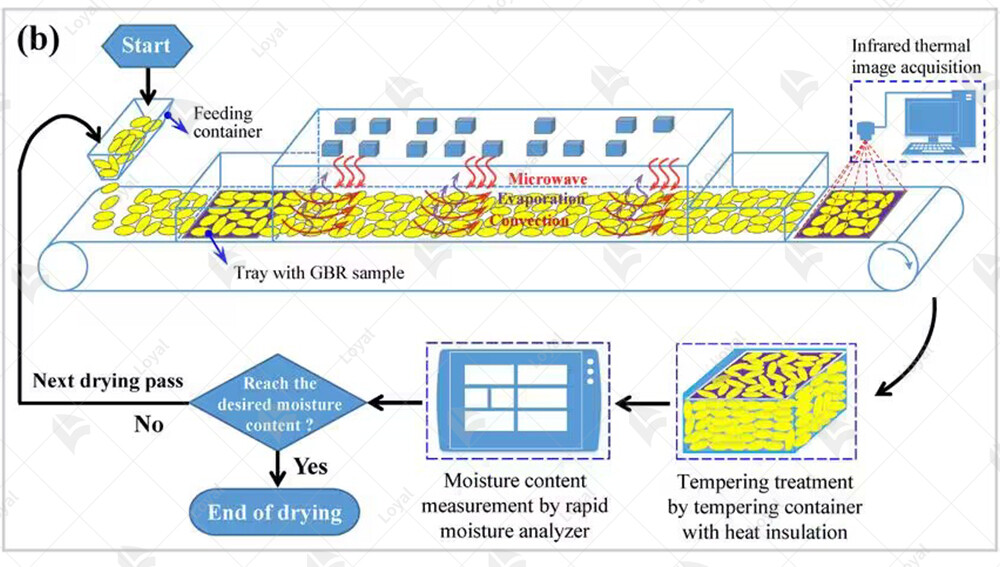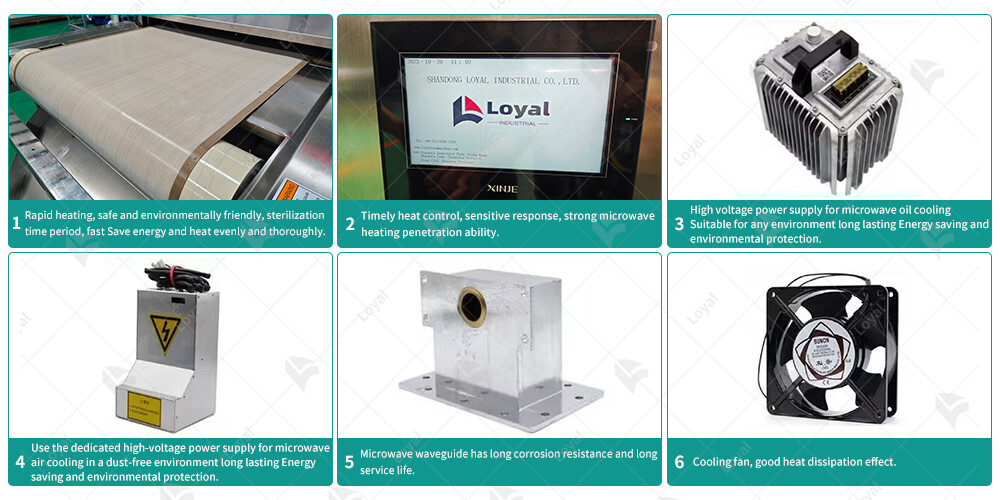The Ultimate Guide to Cumin Seed Microwave Sterilization Machine in 2024
Introduction
In 2024, the utilization of microwave technology in the sterilization of cumin seeds has reached unprecedented levels of efficiency and precision. The Cumin Seed Microwave Sterilization Machine stands as a testament to the advancements in food processing technology, offering unparalleled benefits in terms of safety, quality, and productivity. As a cornerstone of modern food processing facilities, this machine plays a vital role in meeting the stringent requirements of the food industry while ensuring the preservation of the unique flavor and aroma of cumin seeds. This guide aims to provide a comprehensive overview of the Cumin Seed Microwave Sterilization Machine, exploring its operational mechanisms, advantages, applications, and future developments, thereby equipping readers with the knowledge needed to navigate the landscape of cumin seed sterilization in 2024 and beyond.

Working principle
The working principle of the Cumin Seed Microwave Sterilization Machine in 2024 revolves around the application of microwave technology to effectively eliminate harmful microorganisms while preserving the quality of cumin seeds. Within the machine, cumin seeds are exposed to controlled microwave radiation, which penetrates the seeds and disrupts the cellular structure of any present pathogens. This process efficiently deactivates bacteria, viruses, and molds, ensuring the safety and longevity of the cumin seeds without compromising their flavor, aroma, or nutritional value. Additionally, the machine is designed to maintain precise temperature and moisture levels to optimize the sterilization process. Overall, the Cumin Seed Microwave Sterilization Machine offers a rapid and efficient method for ensuring the safety and quality of cumin seeds in 2024 and beyond.

Key components of microwave sterilizer
Component | Description |
Magnetron | The magnetron is the heart of the microwave sterilization machine. It generates microwaves, which are the primary source of energy for sterilizing cumin seeds. |
Waveguide | The waveguide is a metal tube that guides the microwaves from the magnetron to the sterilization chamber. It ensures efficient transmission of microwaves to the cumin seeds. |
Sterilization Chamber | The sterilization chamber is where the cumin seeds are placed for sterilization. It is designed to contain the microwaves and facilitate even distribution of heat for thorough sterilization. |
Conveyor System | The conveyor system transports the cumin seeds through the sterilization chamber at a controlled speed. It ensures uniform exposure to microwaves for consistent sterilization results. |
Control Panel | The control panel allows operators to set and monitor sterilization parameters, such as time, temperature, and power levels. It provides user-friendly interface for operating the machine efficiently. |
Cooling System | The cooling system helps dissipate heat generated during the sterilization process. It prevents overheating of the machine and ensures safe operation over extended periods. |
Safety Features | Safety features include interlocks, emergency stop buttons, and temperature sensors. They are designed to protect operators and prevent accidents during machine operation. |
Air Filtration System | The air filtration system removes any dust or debris from the sterilization chamber, ensuring clean and hygienic conditions for the cumin seeds. It maintains the integrity of the sterilized product. |

Comparison and advantages of microwave technology and traditional sterilization methods
Aspect | Microwave Sterilization | Traditional Sterilization Methods |
Speed | Rapid heating, shorter processing time | Longer processing time required |
Efficiency | Penetrates deep into cumin seeds, uniform sterilization | Surface sterilization, limited penetration |
Energy Consumption | More energy-efficient | Higher energy consumption |
Preservation of Nutrients | Retains more nutrients and flavor | May lead to nutrient loss and flavor changes |
Microbial Reduction | Effective in eliminating bacteria, fungi, and other pathogens | May not achieve complete microbial reduction |
Equipment Size | Compact machines, minimal space requirement | Larger equipment footprint, more space needed |
Safety | Minimal risk of cross-contamination | Potential for cross-contamination |
Cost | Initial investment may be higher, but lower operating costs | Lower initial investment, but higher operating costs due to longer processing times |

Types of microwave sterilizers
Types of microwave sterilizers vary based on their design, functionality, and application in the food processing industry. In 2024, several types of microwave sterilization machines are available, each with its unique features and advantages:
1. Batch Microwave Sterilizers:
Batch microwave sterilizers are designed to process a specific quantity of cumin seeds at a time. They feature a chamber where the cumin seeds are placed for sterilization. Once the desired quantity is loaded into the chamber, the sterilization cycle begins, typically lasting a few minutes to ensure thorough sterilization. Batch sterilizers are suitable for smaller-scale production facilities or for processing limited quantities of cumin seeds.
2. Continuous Microwave Sterilizers:
Continuous microwave sterilizers are designed for high-volume production of cumin seeds. They feature a continuous conveyor belt system that continuously feeds cumin seeds into the sterilization chamber, allowing for uninterrupted processing. Continuous sterilizers are ideal for large-scale production facilities that require efficient and continuous processing of cumin seeds to meet high demand.
3. Hybrid Microwave Sterilizers:
Hybrid microwave sterilizers combine microwave technology with other sterilization methods, such as hot air or steam, to achieve optimal results. These sterilizers offer the benefits of both microwave and conventional sterilization methods, including rapid heating and uniform sterilization. Hybrid sterilizers are versatile and can be customized to meet specific processing requirements for cumin seeds.
4. Customized Microwave Sterilizers:
Some manufacturers offer customized microwave sterilizers tailored to the unique needs of the food processing industry. These sterilizers may incorporate advanced features such as adjustable power levels, variable conveyor speeds, and specialized sterilization chambers to accommodate different types of cumin seeds and processing requirements. Customized sterilizers provide flexibility and efficiency in sterilizing cumin seeds according to specific production needs.

Application of microwave sterilizers
Industry/Application | Description |
Food Processing | Sterilization of cumin seeds in food processing plants to ensure food safety and extend shelf life. |
Spice Production | Sterilization of cumin seeds in spice production facilities to maintain quality and prevent contamination. |
Pharmaceutical Industry | Sterilization of cumin seeds used as herbal remedies or in pharmaceutical formulations to meet regulatory standards. |
Research and Development | Sterilization of cumin seeds in research laboratories for studies on microbial control and product development. |
Export and Import | Sterilization of cumin seeds for export/import purposes, ensuring compliance with international phytosanitary regulations. |

Technological progress and innovation of microwave sterilizers
Technological progress and innovation in microwave sterilizers have significantly advanced the food processing industry, especially in the sterilization of cumin seeds. In 2024, microwave sterilization machines for cumin seeds have undergone remarkable developments to enhance efficiency, precision, and safety.
Advanced Microwave Technology:
Microwave sterilization machines utilize advanced microwave technology to rapidly and effectively eliminate harmful microorganisms in cumin seeds. These machines emit electromagnetic waves that penetrate the seeds, disrupting the cellular structure of bacteria, viruses, and fungi, thus ensuring the microbiological safety of the final product.
Enhanced Efficiency and Speed:
In recent years, there has been a focus on improving the efficiency and speed of microwave sterilizers for cumin seeds. Advancements in microwave technology have led to the development of machines capable of sterilizing larger batches of seeds in shorter timeframes, thus increasing production capacity and reducing processing times.
Precision Control and Uniformity:
Modern microwave sterilization machines offer precise control over key parameters such as power levels, exposure times, and temperature, ensuring uniform sterilization of cumin seeds. This level of control minimizes the risk of under-processing or over-processing, resulting in consistently high-quality sterilized seeds.
Safety Features and Compliance:
To meet stringent food safety regulations and industry standards, microwave sterilization machines for cumin seeds are equipped with advanced safety features. These include automatic shut-off mechanisms, temperature monitoring systems, and built-in alarms to prevent overheating and ensure the safety of operators and the integrity of the seeds.
Innovative Design and Engineering:
The design and engineering of microwave sterilization machines have evolved to optimize performance and usability. Innovative features such as conveyor belt systems, adjustable power settings, and intuitive control interfaces contribute to ease of operation and maintenance, making these machines highly efficient and user-friendly.
Future Prospects:
Looking ahead, the future of microwave sterilizers for cumin seeds is promising, with ongoing research and development aimed at further enhancing performance and capabilities. Emerging technologies such as artificial intelligence, machine learning, and IoT integration are expected to revolutionize the sterilization process, offering even greater precision, efficiency, and automation.

Precautions for selection and implementation of microwave sterilizers
When selecting and implementing a microwave sterilizer for cumin seeds, several precautions should be considered to ensure optimal performance and effectiveness.
1. Compatibility with Cumin Seeds:
Ensure that the microwave sterilization machine is specifically designed and calibrated for sterilizing cumin seeds. It should be capable of effectively penetrating the seeds to eliminate any pathogens or contaminants while preserving their flavor, aroma, and nutritional properties.
2. Power and Frequency Settings:
Verify that the microwave sterilizer offers adjustable power and frequency settings to accommodate the unique characteristics of cumin seeds. Different power levels and frequencies may be required to achieve thorough sterilization without compromising the quality of the seeds.
3. Uniform Heating and Penetration:
Choose a microwave sterilizer that ensures uniform heating and penetration of cumin seeds throughout the sterilization process. This helps to prevent under-processing or overheating of certain seeds, ensuring consistent results and minimizing the risk of quality defects.
4. Safety Features:
Prioritize microwave sterilizers equipped with advanced safety features to protect operators and prevent accidents. These may include automatic shut-off mechanisms, temperature sensors, and door interlocks to ensure safe operation during sterilization cycles.
5. Compliance with Regulations:
Select a microwave sterilizer that complies with relevant regulatory standards and guidelines for food safety and quality. This ensures that the sterilization process meets industry requirements and avoids any potential regulatory issues or liabilities.
6. Validation and Testing:
Before full-scale implementation, conduct validation and testing procedures to verify the effectiveness and reliability of the microwave sterilizer for cumin seeds. This may involve running pilot tests, analyzing sterilization efficacy, and monitoring quality attributes of the sterilized seeds.
7. Operator Training and Documentation:
Provide comprehensive training for operators responsible for operating the microwave sterilizer. Ensure they understand proper procedures, safety precautions, and maintenance requirements. Additionally, maintain detailed documentation of sterilization cycles, operational parameters, and quality control measures for regulatory compliance and quality assurance purposes.

Challenges and limitations of microwave sterilizers
Challenges and limitations are inherent in the design and operation of microwave sterilizers, even in the context of cumin seed processing.
1. Uneven Heating:
Microwave energy can penetrate unevenly through certain materials, leading to uneven heating within the sterilizer chamber. This can result in inconsistent sterilization levels among cumin seeds, potentially leaving some areas underprocessed and vulnerable to contamination.
2. Moisture Content Sensitivity:
The effectiveness of microwave sterilization is highly dependent on the moisture content of the cumin seeds. If the seeds are too dry, they may not absorb sufficient microwave energy to achieve the desired sterilization temperature. Conversely, if the seeds are too moist, they may become overheated and suffer from quality degradation.
3. Equipment Size and Throughput:
The capacity of microwave sterilization machines may be limited by the size of the sterilization chamber and the throughput rate. Processing large volumes of cumin seeds efficiently may require investment in larger or multiple sterilization units, which can increase operational costs and space requirements.
4. Energy Consumption:
Microwave sterilizers consume significant amounts of energy during operation, especially when processing large batches of cumin seeds. Managing energy consumption and optimizing process parameters to minimize wastage without compromising sterilization effectiveness is a constant challenge for operators.
5. Regulatory Compliance:
Meeting regulatory standards for food safety and quality presents a challenge for manufacturers of cumin seed products. Microwave sterilization processes must be validated and documented to demonstrate compliance with industry regulations, adding complexity and cost to the production process.
6. Material Compatibility:
Certain packaging materials and cumin seed varieties may not be suitable for microwave sterilization. Compatibility issues can arise due to factors such as material composition, thickness, and heat resistance, requiring careful selection and testing of packaging materials and cumin seed varieties.
Post-maintenance of microwave sterilizers
Post-maintenance of microwave sterilizers is crucial to ensure their optimal performance and longevity in sterilizing cumin seeds and other food products. Following a rigorous post-maintenance routine helps uphold food safety standards and preserve the quality of sterilized cumin seeds.
Cleaning and Sanitization:
After each use, thoroughly clean and sanitize all components of the microwave sterilization machine. This includes the chamber, conveyor belts, trays, and any other surfaces that come into contact with the cumin seeds. Use approved cleaning agents and follow manufacturer guidelines to eliminate any traces of contaminants and bacteria.
Inspection of Components:
Regularly inspect all components of the microwave sterilization machine for signs of wear and tear. Pay close attention to seals, gaskets, and electrical connections, ensuring they are intact and functioning properly. Replace any damaged or worn-out parts to prevent leakage or malfunction during operation.
Calibration and Adjustment:
Calibrate the microwave sterilization machine according to manufacturer specifications. This involves adjusting power levels, temperature settings, and conveyor speed to ensure consistent and effective sterilization of cumin seeds. Use calibrated instruments and follow standard procedures to achieve accurate results.
Testing and Validation:
Conduct testing and validation procedures to verify the performance of the microwave sterilization machine. Run test cycles with controlled parameters and monitor the sterilization process closely. Validate the effectiveness of the sterilization by testing samples of cumin seeds for microbial load and quality attributes.
Documentation and Record-Keeping:
Maintain detailed records of all maintenance activities and testing results. Document cleaning schedules, component inspections, calibration adjustments, and validation tests. Keep comprehensive records to demonstrate compliance with food safety regulations and quality assurance standards.
Training and Education:
Provide training for operators and maintenance personnel on proper post-maintenance procedures. Ensure that staff members are familiar with the operation of the microwave sterilization machine and understand their responsibilities in maintaining its functionality and cleanliness. Continuous education and training are essential for upholding food safety standards and optimizing machine performance.

References
The following are five authoritative foreign literature websites in the field of industrial microwaves:
1. IEEE Xplore Digital Library
Website: [https://ieeexplore.ieee.org/]
2.ScienceDirect
Website: [https://www.sciencedirect.com/]
3. SpringerLink
Website: [https://link.springer.com/]
4. Wiley Online Library
Website: [https://onlinelibrary.wiley.com/]
5. PubMed
Website: [https://pubmed.ncbi.nlm.nih.gov/]
 Telephone :+86-531-55583139
Telephone :+86-531-55583139 WhatsApp :+86 13256674591
WhatsApp :+86 13256674591 Email :
Email :










